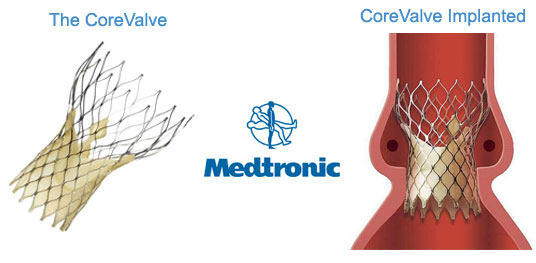Big Technology Update: CoreValve Gets Accelerated FDA Approval
By Adam Pick on June 19, 2014
In case you missed the big news last week…
The CoreValve, a new transcatheter aortic valve replacement (TAVR) device, just received FDA approval for “high risk” patients with severe aortic valve stenosis. It’s big news because this is the second, accelerated FDA approval for this medical device — in less than 6 months. As you might recall, the CoreValve received FDA approval for “inoperable” patients in January.

If you didn’t know, the CoreValve is a next generation TAVR technology that requires no incision to the patient’s sternum or ribs.
Yes, you read that correctly! A CoreValve can be implanted in the patient’s heart using very minimally invasive techniques. Furthermore, the CoreValve leverages self-expanding valve technologies to position the valve.
To help you learn about the CoreValve, here is a very interesting video which shows how this next-generation TAVR valve works.
Why The Accelerated FDA Approval of CoreValve?
The CoreValve received a quick approval from the FDA because it has been shown to have superior results to the traditional surgical aortic valve replacement (SAVR) approaches. Dr. David Adams, the national co-prinicipal investigator of the CoreValve trial, said the following:
“This rigorous trial has defined a new standard for transcatheter valve performance. With this approval we can treat more patients due to the broad range of CoreValve sizes, and we have an option compared to surgery that provides a greater chance for a longer life while minimizing stroke.” — Dr. David Adams, Mount Sinai Hospital
Fyi, the stroke rate of TAVR devices has been called the Achilles heel of TAVR devices. However, the CoreValve patients in this study had less incidence of stroke than patients who underwent surgical aortic valve replacement.
Needless to say, this is a significant step for the advance of valvular therapy, the CoreValve, the Medtronic team, the cardiologists and the surgeons who implant the device, and, ultimately, the patients who greatly benefit from this therapy!
Keep on tickin!
Adam
|
Mary B says on June 24th, 2014 at 7:46 pm |
|
This totally gives me some hope in the future!! |
 |
|
Mary B says on June 24th, 2014 at 7:47 pm |
|
I am feeling hopeful when the day comes for me. Hope this proves to be a wonderful and successful fix!! |
 |
|
Robert Stoltz says on June 28th, 2014 at 9:10 am |
|
Can the core valve be used if the patient has an aortic valve prosthesis in place? ( |
 |
|
Robert Stoltz says on June 28th, 2014 at 9:15 am |
|
If an aortic valve prosthesis fails, does it have to be removed before the core valve can be installed? |
 |
|
Robert Stoltz says on June 28th, 2014 at 9:18 am |
|
Does the aortic valve prosthesis have to be removed before the core valve can be installed? If not, how is it done? |
 |
|
Robert Stoltz says on June 28th, 2014 at 9:19 am |
|
Does a calcified aortic valve prosthesis have to be removed before the core valve can be installed? If not, how is it done? |
 |
|
Patricia says on July 10th, 2014 at 6:23 pm |
|
Will this be THE option when my metal mitral valve will need replacement? |
 |
|
ROBERT STOLTZ says on July 12th, 2014 at 8:34 am |
|
I had a Carpentier Edwards aortic prosthesis (magna ease) implanted on Oct 8 2013 I Have developed thrombocytopenia since, and am concerned that it may have been caused by the implant. Could this valve be replaced with a core valve without removal? Are there any circumstances where the core valve has caused thrombocyto]penia. Robert Stoltz |
 |
|
ROBERT STOLTZ says on July 12th, 2014 at 8:38 am |
|
I had a Carpentier Edwards aortic valve prosthesis (magna ease) implanted on Oct. 8 2013. |
 |
|
Maureen Brown says on October 28th, 2014 at 4:29 pm |
|
I am a rare duck..my heart slows to almost a stop with pain killers and also anesthesia, so the fact that I have aortic stenosis, albeit moderate at present, is terrifying me just knowing I am facing surgery down the road. This may be at least a less evil to open heart surgery for me as far as my reactions to meds…I hope…? |
 |













